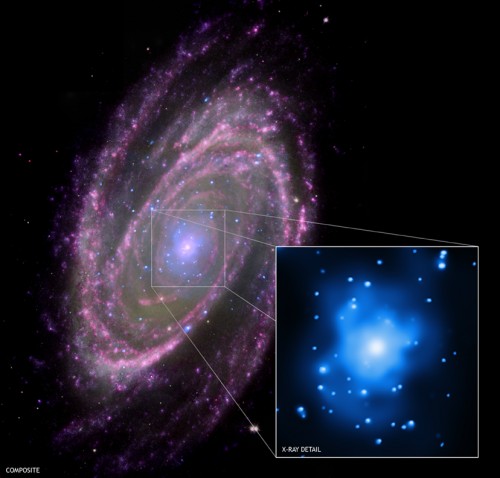Explanation: This impressive color composite shows spiral galaxy M81 across the electromagnetic spectrum. It combines X-ray data (blue) from the Chandra Observatory, infrared data (pink) from the Spitzer Space Telescope, and an ultraviolet image (purple) from the GALEX satellite, with a visible light (green) Hubble image. The inset highlights X-rays from some of M81’s black holes, including black holes in binary star systems with about 10 times the mass of the sun, as well as the central, supermassive black hole of over 70 million solar masses. Comparing computer models of the giant black hole’s energy output to the multiwavelength data suggests that feeding that monster is relatively simple — energy and radiation is generated as material in the central region swirls inwards forming an accretion disk. In fact, the process otherwise appears to be just like the accretion process feeding M81’s stellar mass black holes, even though the central black hole is millions of times more massive. M81 itself is about 70,000 light-years across and only 12 million light-years away in the northern constellation Ursa Major.
antwrp.gsfc.nasa.gov/apod/astropix.html








O_O
worst. galaxy. ever
“only 12 million light-years away”
yeah, that’s barely farther than a trip to the drugstore.
*reads quote*
. . .
What?
Reboot, as far as neighboring galaxies go, 12 million light years IS pretty close. Our closest neighbor is 2.7 million light years away.
@MikeBabaguh
um, I was being facetious; trying to funny. I guess I should stop.
2.7? When I was a kid I’d do that every morning in the snow
in the snow? I’d have to walk that, up hill , both ways ! In my father’s boots.
Oh, never mind.
Too many big words in the quote for my little brain to process. But the picture is very nice!
Put simply: the star, gases and other objects are swirling around the black hole like water going down the drain. This is called an accretion disk, because scientists don’t like to make toilet analogies in their papers. As all that swirling stuff starts going faster and gets compressed, it gives off x-rays, which we can detect. Just to be clear: the x-rays are given off when the swirling matter is close to, but not inside, the event horizon. So while we can’t actually detect the black hole itself, there’s some stuff that acts like it might be near the black hole.